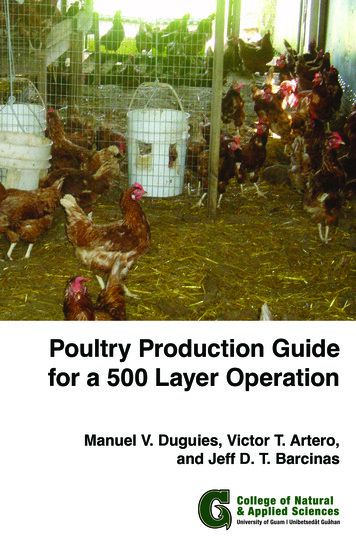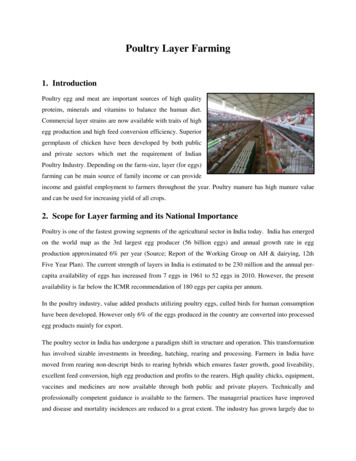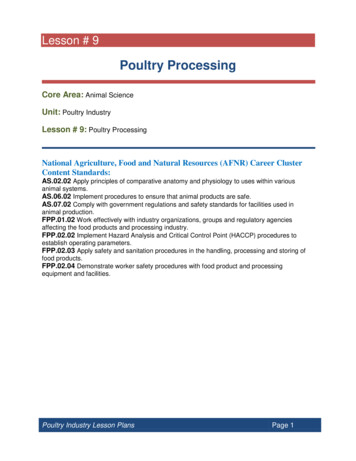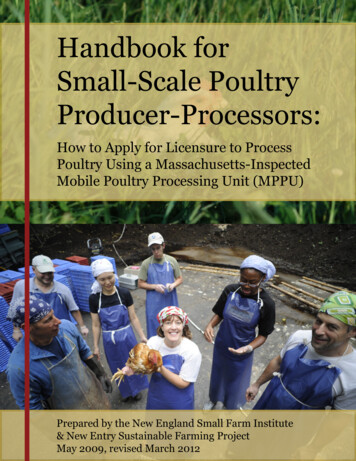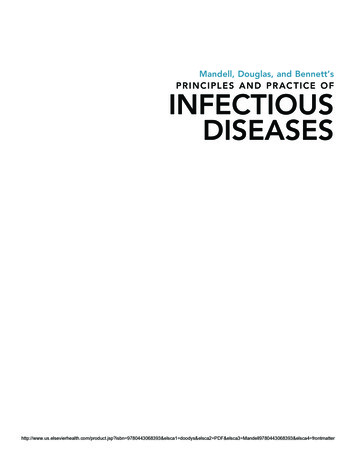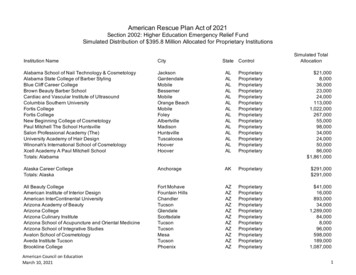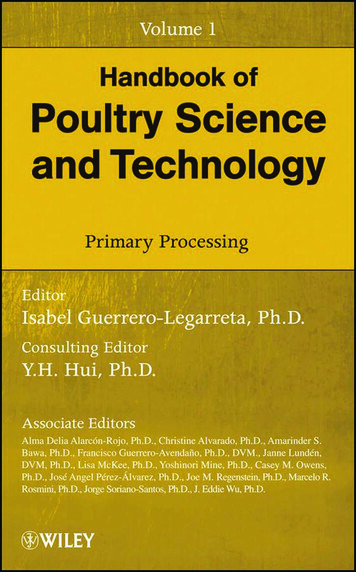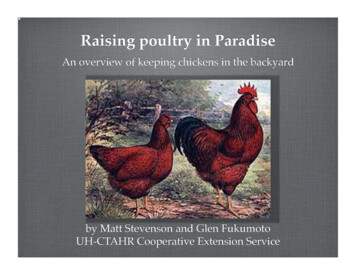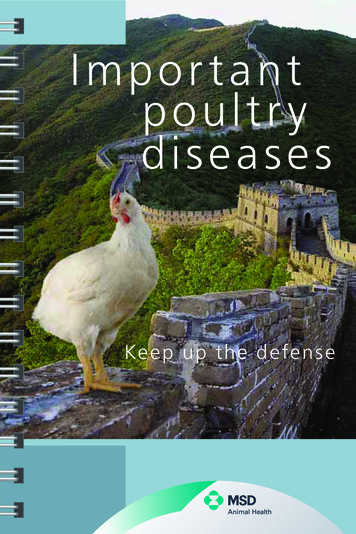
Transcription
I mp or tantpou l tr ydi seas e sKeep up the defense
IMPORTANTPOULTRY DISEASES23
ContentsContentsInfectious Respiratory diseasesMiscellaneous Bacterial DiseasesAspergillosis10Colibacilosis72Avain Influenza12Fowl Cholera76Avian Metapneumovirus Rhinotracheitis/TRT14Infectious Synovitis78Infectious Bronchitis16Necrotic Enteritis80Infectious Coryza20Ornithobacterium Rhinotracheale (OR)84Infectious Laryngotracheitis22Pullorum disease/Fowl Typhoid86Mycoplasma Gallisepticum “CRD”27Mycoplasma Synoviae30Newcastle Disease32Neoplastic DiseasesLymphoid Leucosis36Marek’s disease38Avian Adeno virus DiseasesBlackhead90Coccidiosis92Red Mite96Worms98Deficiency DiseasesRiboflavin102Egg Drop Syndrome ‘7644VitaminD3103Inclusion Body Hepatitis48VitaminE104Miscellaneous Viral Diseases4Parasitic DiseasesFood Safety in PoultryAvian Encephalomyelitis54Introduction106Chicken Anaemia Virus58Salmonellosis106Fowl Pox60Campylobacter111Infectious Bursal Disease62Malabsorbtion Syndrome/ Runting Stunting Syndrome66Reo virus infections68Diagnostics and Sampling1155
ForewordForewordForewordThe first edition of Intervet’s “Important Poultry Diseases” was in1972 and still it is one of our most wanted publications.An easy to handle and practical booklet for basic understanding ofthe most important poultry diseases for people working in poultrymanagement.This is the fifth updated version printed in 2013 with newadditional information based on the new developments in PoultryDiseases and progress of the MSD Animal Health Poultry Researchin developing additional new products.MSD Animal Health Research is committed to co-operate with thepoultry industry worldwide to develop and support solutions tocontrol poultry diseases. MSD Animal Health is more than vaccinesalone.For detailed information of any of our products please contact thelocal MSD Animal Health representative or Intervet InternationalBV– part of MSD Animal Health.Intervet International BVBoxmeer- Holland, P.O. Box 315830 AA Boxmeer, The NetherlandsPhone 31 485587600 - Fax 31 485577333E-mail info@merck.com - www.merck.com67
Infectious Respiratory diseasesInfectious Respiratory diseasesInfectious Respiratory diseasest "TQFSHJMMPTJTt "WBJO *OnVFO[Bt "WJBO NFUBQOFVNPWJSVT 3IJOPUSBDIFJUJT 535t *OGFDUJPVT #SPODIJUJTt *OGFDUJPVT PSZ[Bt *OGFDUJPVT -BSZOHPUSBDIFJUJTt .ZDPQMBTNB (BMMJTFQUJDVN w 3%wt .ZDPQMBTNB 4ZOPWJBFt /FXDBTUMF %JTFBTF89
Infectious Respiratory diseasesAspergillosisInfectious Respiratory diseasesAspergillosisAspergillosis(Fungal Pneumonia)CauseTreatment and controlThe principal fungus causing Aspergillosis in poultry is Aspergillusfumigatus.There no specific treatment for infected birds. The best is to removeand destroy affected birds.Strict hygiene in breeder (hatching eggs) and hatchery management isnecessary. Choice and quality of litter is also important to prevent thatspore bearing wood shavings or straw are used.Hatchery control with anti-fungal disinfectant may be critical tocleaning and disinfection procedures to control fungus infection.TransmissionTransmission is by inhalation of fungus spores from contaminated litter(e.g. wood shavings, straw) or contaminated feed. Hatcheries may alsocontribute to infection of chicks.Species affectedYoung chickens are very susceptible. Older chickens are more resistantto infection. Turkey poults, pheasants, quails, ducklings, and goslingsmay also become infected.Clinical signsInfected chickens are depressed and thirsty. Gasping and rapidbreathing can be observed. Mortality is variable, from 5 to 50 %. Grosslesions involve the lungs and airsacs primarily. Yellow-white pin headsized lesions can be found. Sometimes all body cavities are filled withsmall yellow-green granular fungus growth.DiagnosisThe presence of Aspergillus fumigatus can be identified microscopicallyor sometimes even with the naked eye in the air passages of the lungs,in the airsacs or in lesions of the abdominal cavity. Aspergillosis can beconfirmed by isolation and identification of the fungus from lesions.10Gross lesions of the lungs11
Infectious Respiratory diseasesInfectious Respiratory diseasesAvian InfluenzaAvian Influenza (AI)CauseAvian Influenza is caused by an Orthomyxovirus; there are severalserotypes.Currently we know there are 16 H- types and 9 N-types and they canshow up in all kinds of combinations. For poultry the most importantones are H5, H7 and H9. Pathogenicity varies with the strains HPAI andLPAI (high or low pathogenic AI).TransmissionAI virus is excreted from nares, mouth, conjunctiva and cloaca.Airborne virus particles from the respiratory tract, droppings, andpeople carrying virus on their clothing and equipment are the mainroutes of transmission. Migratory water fowl and other wild birdsinfected with AI virus may be a source of infection.Species affectedAvian Influenza viruses have been shown to naturally infect a widevariety of wild and domestic birds. In poultry production main problemsare in chickens, turkeys and ducks.Avian InfluenzaDiagnosisClinical signs are indicative for AI; final confirmation by laboratory testing:- Direct detection of AI proteins or Nucleic acids(RNA) using PCR.- Virus isolation from infected organs, tracheal or cloacal swabs.- Serology from blood samples after infection and for routinemonitoring showing specific AI antibodies.TreatmentThere is no treatment for Avian Influenza. Antibiotics will help tocontrol secondary bacterial infections.Prevention and controlIn many countries AI is a notifiable disease with specific localregulations on its control.In AI free areas the disease(LPAI and HPAI) is controlled by monitoringand stamping out.In case of LPAI infected areas countries can decide to allow vaccinationonly for LPAI.In case of endemic HPAI and/or LPAI vaccination might be allowed.Vaccination is generally done with inactivated AI vaccines based on thestrain H-type causing the outbreaks.Clinical signsClinical signs will vary, depending on the pathogenicity (HPAI and LPAI)of AI virus involved and other factors as host species, sex, concurrentinfections, acquired immunity and environmental factors.LPAI shows generally mild symptoms: respiratory coughing sneezing,wet eyes, nasal discharge depression, lethargy limited reduction of feedintake and limited drop in egg production; low mortality rate.HPAI shows fast onset with increased mortality even before clinicalsigns are seen, depression, drop in feed and water intake, severe dropin egg production and mortality can vary between 50-90%.12Haemorrhagic comb, wattles and legs in a bird affected by AI.13
Infectious Respiratory diseasesAvian MetapneumovirusAvian Metapneumovirus (aMPV)“Rhinotracheitis” (RT) Turkey Rhinotracheitis (TRT)“Swollen Head Syndrome (SHS)“CauseAvian Metapneumovirus, belongs to the subfamily Pneumovirus fromthe family Paramyxoviridae. Within the aMPV 4 subtypes (A-B-C-D) areidentified.TransmissionThe virus spreads horizontally via direct contact from bird to bird andvia contaminated personnel, water and equipment.Species affectedTurkeys and chickens.Clinical signs and lesionsIn both turkeys and chickens.In young birds the respiratory clinical signs; snicking, rales, sneezing,nasal discharge , foamy conjunctivitis, swollen infraorbital and periorbitalsinus “swollen head” are most prominent; when birds become olderhead shaking and coughing can be added. In adult laying hens theremay a drop in egg production up to 70% with an increased incidenceof poor shell quality.Morbidity is general high (up to 100%); mortality varies from 0.5% upto 50% depending on secondary infections (such as IBV, E.coli) andfarm climate conditions.At post mortem the lesions vary. In an uncomplicated infection:rhinitis, tracheitis and sinusitis will dominate , in case of Swollen HeadSyndrome, oedema at the head often in combination with purulent orcaseous subcutaneous exudate. In complicated cases with E.colipolyserositis including fibrinous exudate in abdominal cavity can be found.Infectious Respiratory diseasesAvian MetapneumovirusDiagnosisClinical signs can give a good indication for aMPV but need to beconfirmed by laboratory testing. Identification of virus by isolation or PCRfrom nasal secretions and/or tracheal or sinus scraping. After infectionseveral serological methods (VN, Elisa, IFT) can be used to detectantibodies. Be aware that vaccines also induce antibodies.TreatmentThere is no treatment for aMPV infections. Treatment with antibioticscan be given to control secondary bacterial infections.PreventionVaccination is the most effective prevention method. Over the years liveand inactivated vaccines have been developed and are very efficaciousin controlling infections. Short living birds will only be vaccinated with alive vaccine(s). Long living birds are advised to be primed with live- andboosted with inactivated vaccines. In this way the birds will have goodlong lasting local and systemic protection.Nasal discharge; wet eye1415
Infectious Respiratory diseasesInfectious BronchitisInfectious Bronchitis (IB)Infectious Respiratory diseasesInfectious BronchitisSpecies affectedChickens are the primary poultry species that is susceptible to IB-virus,but quail and pheasants can be affected.Recent discovery of IB virus in other species without clinical signsindicates that other species may act as vectors.Clinical signsIn young chickens the respiratory form appears with gasping, sneezing,tracheal rales and nasal discharge. Generally chicks are depressed andshow reduced feed consumption. Mortality in general is low unlessinfection gets complicated with secondary bacterial infections (like E.coli).In case of a nephropathogenic type of IB virus generally birds, afterinitial respiratory signs, are more depressed, show wet droppingsresulting in wet litter, increased water intake and increased mortality.CoronavirusCauseInfectious Bronchitis(IB) is present worldwide, it is a highly contagious,acute, and economically important disease. IB is caused by an AvianCoronavirus. In the field, several different IB serotypes have beenidentified including the classic Massachusetts type and a number ofvariants such as IB 4/91, QX, Arkansas and Connecticut.TransmissionThe virus is transmitted rapidly from bird to bird through the airborneroute. The virus can also be transmitted via the air between chickenhouses and even from farm to farm.The incubation period is only 1-3 days.16In adult “laying” birds (layers and breeders) after initial respiratory signsthe affected flocks show a drop in egg production and a loss of eggquality (shell deformation and internal egg changes) resulting in moresecond class eggs, affecting the hatchability rate of fertile eggs andday-old chick quality.A specific condition, called “false layers” is related to the QX type of IB;usually flocks do not peak in egg production and many birds show a“penguin-like posture” .Post mortem lesionsIn young chicks a yellow cheesy plug at the tracheal bifurcation isindicative of IB infection. In case of nephropathogenic infections paleand swollen kidneys and distended ureters with urates are found Inolder birds mucus and redness in the trachea, exudate in the air sacs,and various changes in the oviduct depending on the time and severityof infection. In case of “false layers” permanent lesions in the oviductmake egg production impossible. The oviduct will be blocked and filledwith fluid (cysts) or never developed into an active oviduct.17
Infectious Respiratory diseasesInfectious BronchitisInfectious Respiratory diseasesInfectious BronchitisDiagnosisClinical signs and post mortem lesions in a flock followed by laboratoryconfirmation based on virus isolation and identification with PCR.Serology based on paired blood samples using HI, Elisa or VN tests.TreatmentThere is no treatment for IB.Antibiotics are used to control secondary bacterial infections.PreventionVaccination with strain specific or cross protective live vaccines, and forlayers and breeders the addition of inactivated vaccines at point of layto induce long lasting systemic immunity.Cystic oviduct in an affected (false) layerMisshapen eggs18Thin shelled eggsNormal eggs19
Infectious Respiratory diseasesInfectious Respiratory diseasesInfectious CoryzaInfectious CoryzaCauseThis is a bacterial disease caused by Avibacterium paragallinarum,(in the past known as Haemophilus paragallinarum). There are 3 commonserotypes, representing different immunotypes: A, B, C.TransmissionThe disease spreads from bird to bird and flock to flock by contact andairborne infected dust particles and via the drinking water. Spread byequipment and personnel have also been reported. The incubation periodvaries from 1 to 3 days.Species affectedThe chicken is the natural host for Avibacterium paragallinarum. All agesare susceptible, but the disease is usually less severe in juvenile birds.Clinical signsThe main clinical signs are due to an acute inflammation around the eyesand upper respiratory tract. Signs include a serous to mucoid discharge inthe nasal passage and sinuses, facial edema and conjunctivitis. Feed andwater consumption will be decreased resulting in loss of weight gain andloss of egg production (10-40%) in laying birds. In affected breeders, thehatchability and day-old chick quality might decline. Mortality will vary withthe virulence of the infection, but is generally low. Complicating infectionswith eg IB, ILT, MG, MS and ND can make it worse.Infectious CoryzaControl:EradicationEradication is not economically feasible.TreatmentTreatment with various antibiotics (erythromycin and tetracycline arecommonly used) will alleviate the severity and course of the disease.Relapse often occurs after treatment is discontinued and recovered birdswill remain carriers. Because of noted drug resistance of Avibacteriumparagallinarum, an antimicrobial sensitivity test is recommended.PreventionVaccination is the preferred control method and is standard in mostendemic Coryza areas.There is no cross protection between the serotypes A, B, C.There is cross protection within the serotypes A and C, but recent outbreaksdue to B serotype strains showed there is partial cross protection within theB- serotype. Therefore, besides vaccines made of A, B, C serotype strains,a broader multivalent vaccine based on serotypes A, B, B-variant and C wasdeveloped.Vaccination with multi-serotype inactivated vaccines during the rearingperiod will reduce clinical signs/control Infectious Coryza.DiagnosisA field infection produces similar symptoms to chronic respiratory disease,therefore a diagnosis based only on clinical signs is difficult to establish. Themost certain diagnosis may be obtained by the isolation of the organismfrom the sinus or airsac exudate from affected birds. This procedure mustbe carried out in the laboratory. There is no practical serological test.Typical facial edema2021
Infectious Respiratory diseasesInfectious LaryngotracheitisInfectious Laryngotracheitis (ILT)CauseILT is caused by a Herpesvirus, only one serotype is known.TransmissionThe natural entry of ILT is via the upper respiratory tract and ocularroute. Field spread occurs via direct contact from bird to bird and/ortransmission by contaminated people or equipment (visitors, shoes,clothing, egg boxes, transport crates).Incubation period varies from 4 -12 days.Species affectedChickens are the primary natural host but other species (pheasants) canalso be affected.Clinical signsAn acute respiratory disease with nasal discharge and moist ralesfollowed by gasping, marked respiratory distress and expectoration ofblood-stained mucus in laying birds. Egg production can drop10 -50% but will return to normal after 3-4 weeks. Mortality can varyfrom 5 -70%.Spread through a chicken house is slower compared to IB and ND.Post mortem lesionsLesion are found throughout the respiratory tract but most pronouncedin the larynx and trachea.Depending on the severity of the infection you can find tracheitis withhaemorrhagic and/or diphteric changes.22Infectious Respiratory diseasesInfectious LaryngotracheitisDiagnosisClinical picture with birds showing respiratory distress andexpectoration of bloody mucus are indicative for ILT. Laboratoryconfirmation with: histopathology showing intranuclear inclusionbodies in tracheal epithelial cells, virus isolation from tracheal swabs onembryonated chicken eggs, virus detection with PCR or IFT on trachealsamples.Detecting antibodies from blood samples after infection.TreatmentThere is no treatment for ILT; emergency vaccination in the early stageof an infected flock may reduce the spread and limit the outbreak.Prevention and controlIn many countries vaccination is the preferred control method.Though in some countries it is not allowed to vaccinate or only underrestriction.The existing live conventional CEO ILT vaccines are effective incontrolling clinical problems but have the risk of spreading andreversion to virulence after multiple passage through chickens.Recent outbreaks show often the relation to the live vaccine strainsused in an area. Therefore, the new generation of recombinant vectorvaccines are more suitable in the control and prevention of ILT.Recombinant vaccines based on HVT-vector carrying inserts ofimportant immunogenic ILT proteins show good efficacy and do notspread and cannot revert to virulence because there is not a full ILTvirus involved.23
Infectious Respiratory diseasesInfectious Respiratory diseasesInfectious LaryngotracheitisInfectious Laryngotracheitis1101009080706050403020100Gasping bird ILT infection19 20 21 22 23 24 25 26 27 28 29 30 31 32 33 34 35 36 37 38 39 40Standard livabilityFlock livability% ProductionMortality & production drop due to ILT infection2425
Infectious Respiratory diseasesInfectious Respiratory diseasesMycoplasma gallicepticumMycoplasma gallicepticum(CRD)CauseThe underlying cause of CRD is Mycoplasma gallisepticum (MG). Thecondition is frequently triggered by respiratory viruses such as ND andIB and subsequently complicated by bacterial invasion. The main agentsinvolved in the infection are Mycoplasma gallisepticum and E. coli.Stress caused by moving the birds, by debeaking, other operations/handlings or other unfavorable conditions e.g. cold or bad ventilation,make the birds more susceptible.TransmissionThe main problem is that parent birds infected with Mycoplasmagallisepticum can transmit the organism through the egg to theiroffspring (vertical transmission). In addition, infection can occur bycontact or by airborne dust or droplets (horizontal transmission).The incubation period varies from 4 days to 3 weeks.Species affectedChickens and Turkeys.Airsacculitis andfoamy contentin the abdominalcavity2627
Infectious Respiratory diseasesMycoplasma gallicepticumInfectious Respiratory diseasesMycoplasma gallicepticumClinical signsTreatmentYoung chickens (broilers or layer pullets) will show respiratory distress.The birds frequently show lack of appetite, decreased weight gain andincreased feed conversion ratios.Treatment of MG-infected chickens or turkeys with suitable antibioticsor chemotherapeutics has been found to be of economic value, but willnot eliminate MG from the flock.In adult birds the most common signs are sneezing and generalrespiratory distress. In laying birds a drop in egg production between20-30 % can occur. In breeders hatchability can be affected and day-oldchick quality produced from hatching eggs coming from infected flockswill be reduced.CRD does not normally cause an alarming number of deaths. The effectis more of a chronic nature causing reduced weight gain and higherfeed conversion ratios in broilers and lower egg production in breedersand layers. In this way the overall economic losses can be very high.PreventionPrevention by monitoring and vaccination has become a more effectivemethod of combating the disease especially in layers. Economic lossesin commercial layers can be reduced by proper use of MG vaccines.Eradication programs (first in breeder flocks) based on stringentmonitoring and culling are preferred in breeders to prevent verticaltransmission. This is only economically possible when prevalence is low.Internal lesionsA reddish inflamed trachea and/or frothy, cheesy exudate in the airsacs,especially in complicated cases (e.g. with secondary E. coli infections)are observed. In mild MG infections the only lesion might be slightmucus in the trachea and a cloudy or light froth in the airsacs.DiagnosisDiagnosis of MG infection can be made based on clinical signs and postmortem lesions followed by confirmation in the laboratory using blood(serum) samples for serology or organs swabs for identification by PCRor mycoplasma isolation.Differential diagnosisRespiratory virus infection (Newcastle disease or infectiousbronchitis) with secondary infection (E. coli, etc.) can give similarlesions.28Pericarditis, peritonitisand perihepatitis isfrequently observedin birds with CRD29
Infectious Respiratory diseasesInfectious Respiratory diseasesMycoplasma SynoviaeMycoplasma SynoviaeCauseMycoplasma synoviae (MS) infection most frequently occurs assubclinical upper respiratory tract infection inducing airsac lesions.After MS becomes systemic it can induce acute to chronic infectionof synovial membranes of joints and tendons resulting in synovitis,tendovaginitis or bursitis. Recently MS was isolated from laying flockswith drop in egg production and/or misshapen eggs (so called “glasswindow eggs”).TransmissionMycoplasma synoviae is spread horizontally via direct contact andvertically from parent to progeny.Species affectedChickens and turkeys are the natural hosts for Mycoplasma synoviae.Other species can be infected but do not show clinical problems.Clinical signsFirst recognized signs are pale comb, lameness, retarded growth and,as the disease progresses, ruffled feathers, swelling of joints and breastblisters.Respiratory involvement is generally asymptomatic but is possible;usually 90-100% of the birds will be infected.Clinical synovitis varies around 5-15% in an infected flock. Mortalityis low around 1% (exceptional up to 10%). More recent strains induceddrop in egg production and/or misshapen eggs (so called “glasswindow eggs”).Mycoplasma SynoviaeLesionsIn general no lesions are found in the respiratory tract.At post mortem from the early stage of synovitis, a viscous creamy togray exudate involving synovial membranes of tendon sheaths, jointsand keel bursa can be found; other findings are liver and kidney swelling.DiagnosisOrganism confirmatory diagnosis based on isolation and identificationof Mycoplasma synoviae can be done by culturing or PCR. Serologicalmonitoring can be done with serum plate agglutination (RPA), Elisa andHI tests.TreatmentMycoplasma synoviae is susceptible to several antibiotics. Antibiotictreatment will diminish clinical signs but not eliminate MS from a flock.Control and preventionPrevention by monitoring and vaccination has become a more effectivemethod of combating the disease especially in layers. Economic lossesin commercial layers can be reduced by proper use of MS vaccines.Eradication programs(first in breeder flocks), basedon stringent monitoring andculling, are preferred in breedersto prevent vertical transmissionand are only economicallypossible when prevalence is low.a so called “glass window egg”3031
Infectious Respiratory diseasesInfectious Respiratory diseasesNewcastle DiseaseNewcastle DiseaseNewcastle Disease (ND)CauseIntestinal lesionsNewcastle disease is caused by a Paramyxovirus (APMV-1). Only oneserotype of ND is known. ND virus has mild strains (lentogenic),medium strength strains (mesogenic), and virulent strains (velogenic).The strains used for live vaccines are mainly lentogenic.Inflamed tracheas, pneumonia, and/or froth in the airsacs are the mainlesions. Haemorrhagic lesions are observed in the proventriculus andthe intestines.TransmissionNewcastle disease virus is highly contagious through infected droppingsand respiratory discharge between birds. Spread between farms is byinfected equipment, trucks, personnel, wild birds or air. The incubationperiod is variable but usually about 3 to 6 days.Species affectedDiagnosisClinical signs followed by laboratory confirmation. Be aware that otherrespiratory infections like IB, ILT and AI can give similar signs.Confirmation can be obtained with virus isolation and identificationfrom tracheal or cloacal swabs, or PCR, Serology testing with HI or Elisameasures the antibody response after infection. Be aware thatvaccination also induces antibody response.Chickens and turkeys.TreatmentClinical signsThere is no specific treatment for ND; antibiotic treatment of secondarybacterial infections (eg E.coli) will reduce the losses.Highly pathogenic strains (velogenic) of ND cause high mortality withdepression and death within 3 to 5 days. Affected chickens do notalways exhibit respiratory or nervous signs. Mesogenic strains causetypical signs of respiratory distress.Labored breathing with wheezing and gurgling, accompanied bynervous signs, such as paralysis or twisted necks (torticollis) are themain signs. Drop in egg production 30 to 50 % or more, returning tonormal levels in about 2-3 weeks is observed. Besides also egg shellquality will be affected (thin, loose color). In well-vaccinated chickenflocks clinical signs may be difficult to find.3233
Infectious Respiratory diseasesNeoplastic DiseasesPrevention and controlVaccination has proven to be a reliable control method. But ND isa notifiable disease, and in many countries the control is based on acombination of obliged vaccination and stamping out in case ofoutbreaks. A wide range of live and inactivated vaccines are used invaccination programs to prevent ND.“The new generation” of live recombinant HVT-vector vaccines give theopportunity for early hatchery vaccination and can be used to replaceconventional ND vaccination, eliminating vaccination reactions andinducing life long protection.Neurotropic formof ND(torticollis)34Neoplastic DiseasesNewcastle Diseaset -ZNQIPJE -FVDPTJTt .BSFL T EJTFBTFHaemorrhagicproventriculus35
Neoplastic DiseasesLymphoid LeucosisLymphoid Leucosis(Big liver disease, visceral leucosis)CauseLymphoid leucosis (LL) is caused by a Retrovirus.TransmissionThe lymphoid leucosis is transmitted vertically through eggs; horizontaltransmission at a young age may occur.Clinical signsVisceral tumours are the main feature of lymphoid leucosis. They can befound in the liver, spleen, kidneys, and bursa of birds that are in generalolder than 25 weeks. In affected layer flocks a lower egg production canbe observed.Neoplastic DiseasesLymphoid LeucosisLeucosis“J” Virus: within the known subgroup of exogenous LL viruses(A, B, C and D), a new subgroup denominated “J” emerged. The “J”virus shows tropism for cells of the myelomonocytic series, causingtumors, which are identified by histopathology as being myelocytomas.The virus has tropism for meat–type birds. The tumours caused by thisvirus are normally seen from sexual maturity (after 14 weeks of age)onward and are frequently located on the surface of bones such as thejunction of the ribs, sternum, pelvis, mandible and skull and may bealso found in visceral organs.Treatment and controlNo treatment is known. The best control method is the laboratorydetection of infected breeders. Eradication of the virus from primarybreeding stock is the most effective way of controlling infections inchickens.DiagnosisInfected breeders can be detected by testing blood samples (monitoring)and virus isolation from hatching eggs and cloacal swabs for the presenceof the virus. In this manner eradication of lymphoid leucosis will bepossible.Osteopetrosis is lymphoid leucosis of the bones of legs and wings whichbecome enlarged, but is quite rare. Affected birds have bowed, thickenedlegs. Lymphoid leucosis can also occur as blood leucosis. Such erythroidand/or myeloid leucemias are also quite rare.Lymphoid Leucosis (big liver)Right: normal Left: affectedAffected birds are listless, pale, and are wasting away. Because of thetumours, LL may be confused with Marek’s disease, but in LL thenervous system is never involved (no paralysis). LL generally causesbirds to weaken, lose weight and eventually die. Histopathologicalexamination is essential for a proper diagnosis.3637
Neoplastic DiseasesNeoplastic DiseasesMarek’s diseaseMarek’s diseaseMarek’s Disease(MD, Neurolymphomatosis)CauseMarek’s disease is caused by a alphaherpesvirus.TransmissionThe disease is highly contagious. Main transmission is by infectedpremises, where day-old chicks will become infected by the oral andrespiratory routes. Dander from feather follicles of MD-infected chickenscan remain infectious for more than a year. Young chicks are particularlysusceptible to horizontal transmission. Susceptibility decreases rapidlyafter the first few days of age.Species affectedEspecially chickens, also quail, turkeys and pheasants are susceptible.Clinical signsInfected birds show weight loss, or may exhibit some form of paralysis.The classical form: neurolymphomatosis (paralysis) with leg nerveinvolvement causes a bird to lie on its side with one leg stretched forwardand the other backward. When the gizzard nerve is involved, the birds willhave a very small gizzard and intestines and will waste away.Acute Marek’s disease is an epidemic in susceptible or unvaccinated flockscausing depression paralysis, mortality and lymphomatousinfiltrations/tumours in multiple organs. Subclinical infections resultin impaired immune responses as MDV causes a lytic infection inlymphocytes.Mortality usually occurs between 10 and 20 weeks of age and can reachup to 50% in unvaccinated flocks.MD leg paralysisDiagnosisThe presence of tumours in liver, spleen, kidneys, lungs, ovary, muscles,or other tissues is indicative of MD, but they can also be indicative oflymphoid leucosis. However, nerve involvement, e
MSD Animal Health Research is committed to co-operate with the poultry industry worldwide to develop and support solutions to control poultry diseases. MSD Animal Health is more than vaccines alone. For detailed information of any of our products please contact the local MSD Animal

